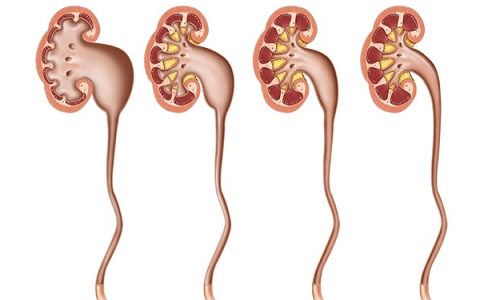Urine is formed in human kidney tissues, it accumulates in the pelvis to then pass through the ureter into the bladder. When for a number of reasons the main renal functions deteriorate, the parenchyma becomes atrophy, the hydrostatic pressure in the kidneys increases or the outflow of urine is disturbed, the excess fluid accumulates in the kidney and the pathological expansion of the calyx and pelvis system begins to progress. Such a condition in the medical language is called hydronephrosis or hydronephrosis transformation.

Renal hydronephrosis is more often diagnosed in the female population at the age of 20-35 years, more often unilateral. Men, although not so often, are also prone to such a disease. This pathology is considered very dangerous, since it can lead to absolute renal dysfunction, which threatens the patient's life.
Clinical picture of the disease
A similar pathology of the kidneys usually differs in a latent flow, revealing itself only in case of any infection, trauma or palpation during medical examination. Renal hydronephrosis does not have a specific symptomatology, which is specific for this pathology. Usually, the disease manifests itself as a pain syndrome in the lower back, abdomen, sacrum, or along the ureter. Constantly aching tenderness can disturb at any time of the day and does not change intensity when changing the position of the body. At the initial stages, the hydronephrosis pain syndrome is somewhat reminiscent of renal colic. Painful attacks are characterized by increased blood pressure, bloating of the abdominal cavity and vomiting and vomiting syndrome, increased swelling.
Warning! It often happens that hematuria acts as the only clinical manifestation of hydronephrosis transformation. And more than 75% of cases revealed microhematuria.
 In some patients, the volume of urine output decreases significantly shortly before the onset of the attack, although after it the amount of urine increases again. If the development of hydronephrosis has reached late stages, then acute pain no longer worries patients. If the pathology is of an infectious nature, then an increase in the overall temperature may be added to the main clinic. A large amount of urinary accumulation is said when it is found in the hypochondrium of a tumor-like formation. Such a sign is important. Sometimes the only clinical sign of the disease is hematuria, which implies the presence of bloody impurities in urine. Some patients with hydronephrosis notice the appearance of painful and frequent urination.
In some patients, the volume of urine output decreases significantly shortly before the onset of the attack, although after it the amount of urine increases again. If the development of hydronephrosis has reached late stages, then acute pain no longer worries patients. If the pathology is of an infectious nature, then an increase in the overall temperature may be added to the main clinic. A large amount of urinary accumulation is said when it is found in the hypochondrium of a tumor-like formation. Such a sign is important. Sometimes the only clinical sign of the disease is hematuria, which implies the presence of bloody impurities in urine. Some patients with hydronephrosis notice the appearance of painful and frequent urination.
Classification of pathology
Specialists classify hydronephrosis in accordance with the stages of its development:
- I stage refers to early development. Moreover, in the pelvis and calyx, extra urine accumulates, causing the pressure in these departments to increase, forcing them to stretch( pyeloectasia).The walls of these kidneys are highly elastic, so in the first stage the kidney still manages to cope with the increased pressure inside it;
- II stage is characterized by a loss of renal function by almost 30-40%.This is due to the expansion of calyxes and pelvis under the influence of liquid pressure, which leads to thinning and structural changes in the tissues of the kidneys;
- III stage is characterized by renal atrophy at 70-100%, which is accompanied by a twofold increase in pelvis and calyx( hydrocalichosis);
- IV stage is characterized by the fact that the kidney completely stops functioning, it is more common for a two-way process.

Also hydronephrosis is classified:
- , depending on the causes on the congenital and acquired form;
- , depending on the lesion on unilateral( left- or right-sided) and bilateral hydronephrosis;
- depending on the course of the acute and chronic forms.
What is the cause of hydronephrosis
The disease develops due to a violation or absolute cessation of urine from the kidney to the bladder, which occurs for a number of physiological or anatomical factors. Hydronephrosis is usually preceded by an abnormally located renal artery that causes compression of the ureter, urinary tract dyskinesia, ureterocele, retrovascular ureter, obstruction of the urinary tract, stricture and ureter valves of an innate nature. Call the disease can and an additional kidney vessel, passing to the bottom of the kidney from the aorta. This additional vessel is placed criss-crosswise with the ureter and presses on it, which leads to constriction.
Secondary form of the disease often develops on the background of urological pathologies such as prostate or urinary tumors, renal stone pathology, narrowing of the urinary tract of traumatic etiology, infiltration of the small pelvis or retroperitoneal tissue, changes in the urinary system of inflammatory nature, tumor metastases in the abdominal lymph nodes, spinal injuries causingviolations of the urine flow.
Caution! If there are sharp pains in the area of the sacrum, waist or abdomen, accompanied by urine with bloody impurities, it is necessary to undergo a comprehensive examination, since such a clinic may indicate the development of renal hydronephrosis.
Hydronephrosis of a bilateral character develops in the case when a urethra and bladder have a pathological abnormality of the urinary flow. This leads to an increased fluid retention causing hydrorephrosis of both kidneys. If, as a result of excessive pressure, there is also an enlargement of the ureter, then ureterohydronephrosis develops. In some patients, pathology develops due to the presence of various obstructions to the urinary flow such as concrements, diverticula, tumor formations, spurs or valves. Similar obstacles can be located in the bladder, pelvis, ureteral wall, urethra, etc. To the development of such a pathological condition leads to unsuccessful surgery, kidney displacement, neuromuscular pathology of the bladder or ureter.
Possible hydronephrosis complications of
A dangerous complication of hydronephrosis transformation is renal failure and atrophy. In connection with changes in tissues, the kidney loses its functionality, and there comes a fatal outcome from intoxication with metabolic products. Because of renal dysfunction, the content of residual nitrogen and other substances, normally excreted through the kidneys with urine, increases in the blood. To avoid fatal intoxication, patients are shown to remove the affected organ, after which the patients undergo hemodialysis procedures with an artificial kidney apparatus or transplant the organ from the donor. Against the backdrop of hydronephrosis, hypertension, which is difficult to treat, can develop.
Most cases of hydronephrosis( more than half) have left-sided localization, in approximately 40% of cases pathology affects the right kidney and only 5% of hydronephrosis transformation is bilateral.
Hydronephrosis is also dangerous for the development of urolithiasis, in parallel with which pyelonephritis( inflammatory disease of the renal parenchyma and the bowl-and-pelvis system) can only develop, which only complicates the course of the pathology. It is known that the consequence of pyelonephritis was the formation of a puff filled pus from the kidney. The course of hydronephrosis transformation can also be complicated by a sudden cup or pelvic rupture, which will lead to urine outflow directly into the peritoneum. If the pathology is accompanied by hematuria, then there is a real threat of developing persistent anemia, accompanied by a decrease in hemoglobin and red blood cells.
The correct approach to the diagnosis and treatment of
Since hydronephrosis is very dangerous, with the slightest suspicion of pathology, it is necessary to undergo a survey. Only a qualified doctor can correctly understand the situation, correctly diagnose pathology and prescribe the necessary therapy. An important stage of diagnosis is the identification of the causes that led to the onset of the disease. Therefore, diagnostics is complex and comprehensive. To begin with, the patient takes urine and blood for laboratory analysis. Then the specialists check the kidneys for ultrasound to determine the presence of changes in the tissues and structural departments of the organ. To determine the degree of functional renal impairment, patients undergo angiography, x-rays and CT.When confirming the pathology, it is necessary to start therapy immediately, since delay can cause complications.
Warning! When hydronephrosis transformation, patients should not eat fatty foods and more than 2 liters of water per day.
The primary goal of the treatment is to eliminate the causes of hydronephrosis, and specialists should do everything possible to reduce the pelvis and ensure the preservation of the kidney. Practice shows that conservative therapy is not able to completely restore renal function. Treatment with medicines hydronephrosis transformation is usually done only to alleviate the symptoms, as well as preoperative therapy. Surgical intervention can completely relieve the patient or partially reduce the clinical symptoms of hydronephrosis. Everything depends on the course of the pathology and its staging.
In acute flow with a special drainage needle, specialists remove urine from the kidneys. If the disease is complicated by an infection process and a blockage, a special catheter is inserted in the kidney of the kidney to allow the kidneys to remove excess urine. Surgical treatment is of an individual nature, but most often it is performed endoscopically. The positive side of this technique is the lack of the need for a large incision, which makes it less traumatic and more acceptable. The operation is performed through two abdominal punctures, so the risk of complications is minimal. At the death of the organ, complete removal of the affected kidney is indicated( or two if hydronephrosis is bilateral).
If there are any obstacles to the urine flow, then without surgical treatment is indispensable. Post-operative rehabilitation lasts about a month, during which the doctor follows the patient's supervision. All this time the patient undergoes therapeutic procedures to restore renal functions, return work capacity. After rehabilitation, the patient passes a few more years of periodic examinations, and adhere to a specialized diet.



